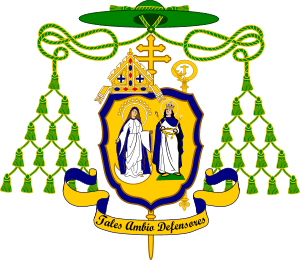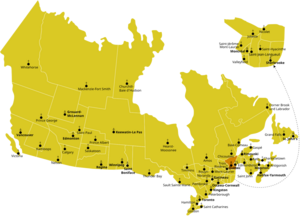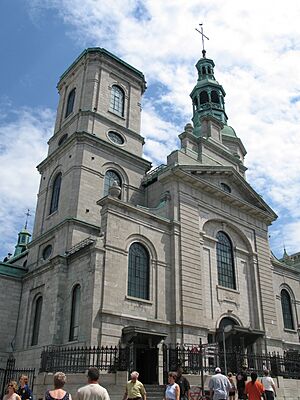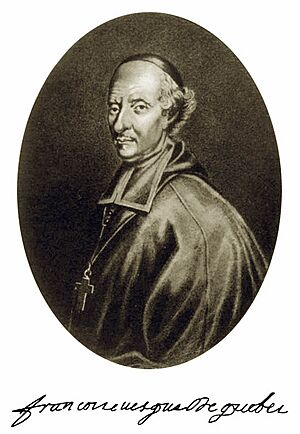Roman Catholic Archdiocese of Quebec facts for kids
Quick facts for kids Archdiocese of QuébecArchidiœcesis Quebecensis Archidiocèse de Québec |
|
|---|---|

Coat of arms
|
|
| Location | |
| Country | |
| Territory | Quebec City |
| Ecclesiastical province | Quebec |
| Statistics | |
| Area | 35,180 km2 (13,580 sq mi) |
| Population - Total - Catholics |
(as of 2017) 1,277,354 1,015,815 (79.5%) |
| Parishes | 40 |
| Information | |
| Denomination | Catholic Church |
| Sui iuris church | Latin Church |
| Rite | Roman Rite |
| Established | 12 January 1658; 367 years ago |
| Cathedral | Notre-Dame de Québec |
| Patron saint | Immaculate Conception and Louis IX of France |
| Secular priests | 737 |
| Current leadership | |
| Pope | Francis |
| Archbishop | Gérald Lacroix |
| Auxiliary Bishops | Marc Pelchat Juan Carlos Londoño |
| Map | |
 |
|
The Archdiocese of Québec is a special area of the Catholic Church in Quebec, Canada. It is like a large church district led by an archbishop. This archdiocese is the oldest Catholic area north of Mexico in the New World. It is also considered the most important Catholic area in Canada.
The Archdiocese of Québec is the main church district for other smaller Catholic areas called suffragan dioceses. These include Chicoutimi, Sainte-Anne-de-la-Pocatière, and Trois-Rivières. The main church for the archdiocese is Notre-Dame de Québec Cathedral in Quebec City.
Contents
History of the Archdiocese
Early Days in New France
When Europeans first started settling in the New World, the Church played a big role in the new colony of New France. Even during the first trips by Jacques Cartier in the 1500s, priests traveled with the explorers.
In 1608, Québec City was founded by Samuel de Champlain. This gave the Church a strong base to share its faith with the Indigenous people. In 1615, missionaries called Recollets arrived, followed by Jesuits 10 years later. Their presence helped the colonies grow and gave the Church a lot of influence in local decisions.
In 1658, the Church created an "apostolic vicariate" for Québec. This was a special church area that reported directly to the Pope. François de Laval was the first leader of this area. He was a very important member of the Sovereign Council of New France, which was the government of the colony. Even though he was mainly in charge of spiritual matters, he had a lot of power because he was the highest Church representative and had good connections with King Louis XIV.
In 1663, Laval started the Seminary of Québec, a school for priests. By 1674, New France was growing fast, and the Pope made the apostolic vicariate into a full diocese. This meant it was a permanent church district. At its largest in 1712, the Diocese of Québec covered almost all of North America, from Canada down to the Gulf of Mexico.
Under British Rule
After Great Britain took over New France in 1760, Catholics in Québec faced challenges. They were often treated unfairly because of their Catholic faith and French language. To hold a public job in the British Empire, people had to take an oath that went against their Catholic beliefs. This stopped most French-speaking Catholics from being involved in local government.
However, in 1774, the British Parliament passed the Quebec Act. This law allowed Québec to use French laws for private matters and let the Church collect money from Catholics to support itself. In 1819, the diocese became an "archdiocese," which is a larger and more important church district. As the population grew, the Archdiocese of Québec was divided into new dioceses.
The Archdiocese Today
Over time, the Archdiocese of Québec became smaller as new dioceses were created from its territory. These new areas included Halifax, Kingston, Charlottetown, St. Boniface, and Montréal.
It is common for the Archbishops of Québec to become cardinals, who are high-ranking officials in the Catholic Church. On September 17, 2024, Pope Francis sent Archbishop Jean-Marc Aveline as a special guest for the archdiocese's 350th anniversary celebrations.
Primate of Canada
Since January 24, 1956, the Archbishop of Quebec has held the special title of Primate of Canada. This title was given by Pope Pius XII and shows the historical importance of the Archdiocese of Québec in Canada.
Bishop's Palace and Chapel
A special building called the Bishop's Palace was built in 1693-1694. It had a private chapel for the Bishop of Quebec. After the British took over, this chapel was used by the government of Quebec for many years.
The original chapel was taken down in 1831 to make space for a new building where the government met. This new building and the bishop's home were later demolished in 1852-1853. A new bishop's residence was built nearby.
Another parliament building was completed in 1854, but it burned down soon after. It was rebuilt by 1860 and served as the Parliament for the new province of Quebec starting in 1867. This building also burned down in 1883. Today, the old Parliament site is a park called Parc Montmorency.
Leadership of the Archdiocese
The Archdiocese of Quebec has been led by many important people since it began.
Leaders of New France
- François de Laval (1658–1674) - He was the first leader, called an Apostolic Vicar.
Bishops of Québec
- François de Laval (1674–1688) - He became the first Bishop when the area became a full diocese.
- Jean-Baptiste de la Croix de Chevrières de Saint-Vallier (1688–1727)
- Louis-François Duplessis de Mornay (1727–1733)
- Pierre-Herman Dosquet (1733–1739)
- François-Louis de Pourroy de Lauberivière (1739–1740)
- Henri-Marie Dubreil de Pontbriand (1741–1760)
- Jean-Olivier Briand (1766–1784)
- Louis-Philippe Mariauchau d'Esgly (1784–1788)
- Jean-François Hubert (1788–1797)
- Pierre Denaut (1797–1806)
- Joseph-Octave Plessis (1806–1819)
Archbishops of Québec
- Joseph-Octave Plessis (1819–1825) - He was the first Archbishop when the diocese became an archdiocese.
- Bernard-Claude Panet (1825–1833)
- Joseph Signay (1833–1850)
- Pierre-Flavien Turgeon (1850–1867)
- Charles-François Baillargeon (1867–1870)
- Cardinal Elzéar-Alexandre Taschereau (1870–1898)
- Cardinal Louis Nazaire Bégin (1898–1925)
- Paul-Eugène Roy (1925–1926)
- Cardinal Felix-Raymond-Marie Rouleau (1926–1931)
- Cardinal Jean-Marie-Rodrigue Villeneuve (1931–1947)
- Cardinal Maurice Roy (1947–1981)
- Cardinal Louis-Albert Vachon (1981–1990)
- Maurice Couture (1990–2002)
- Cardinal Marc Ouellet (2002–2010)
- Cardinal Gérald Lacroix (2011–present)
Assistant Bishops
Sometimes, a bishop has assistants. These are called "coadjutor bishops" or "auxiliary bishops." A coadjutor bishop is special because they are next in line to become the main bishop when the current one leaves. Auxiliary bishops help out but do not automatically take over. Many of these assistant bishops later became leaders of the Archdiocese of Quebec or other dioceses.
Recent Appointments
On February 22, 2011, Pope Benedict XVI named Bishop Gérald Lacroix as the new Archbishop of the Roman Catholic Archdiocese of Quebec and Primate of Canada. Before this, he was an Auxiliary Bishop for Quebec. He took over from Marc Ouellet, who moved to a different important role in the Vatican.
Archbishop Lacroix was born in Saint-Hilaire-de-Dorset, Quebec, in 1957. His family moved to Manchester, New Hampshire, in the U.S., when he was 8. He joined a religious group called the Pius X Secular Institute in 1975. He became a priest in 1988 and an Auxiliary Bishop in 2009.
On December 12, 2011, Pope Benedict appointed Gaetan Proulx and Denis Grondin Jr. as new Auxiliary Bishops for Archbishop Lacroix. They became bishops on February 25, 2012.
Later, Bishop Grondin became the Archbishop of Rimouski in 2015. Bishop Proulx became the Bishop of Gaspé in 2016. In October 2016, Pope Francis appointed Louis Corriveau and Marc Pelchat as new Auxiliary Bishops for the Archdiocese. In 2019, Bishop Corriveau moved to a different diocese, and Martin Laliberté became an auxiliary bishop here.
See also
 In Spanish: Arquidiócesis de Quebec para niños
In Spanish: Arquidiócesis de Quebec para niños
- Ursulines of Quebec
- Manresa Spirituality Centre



